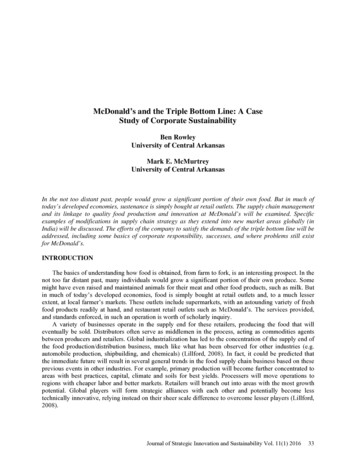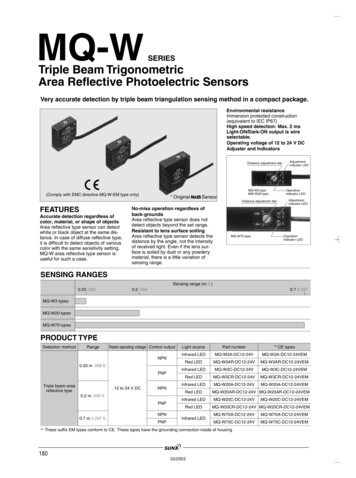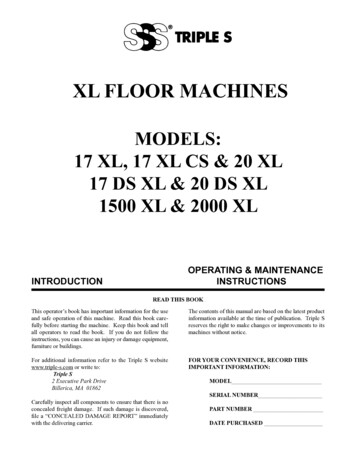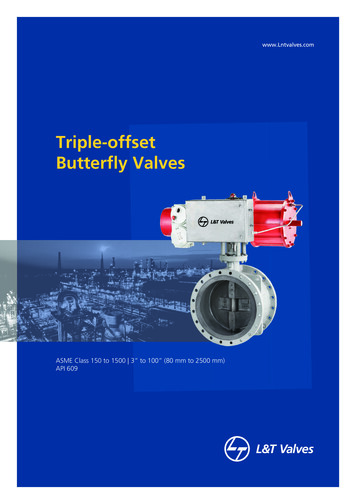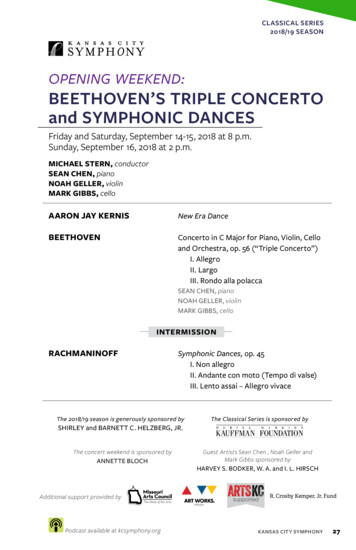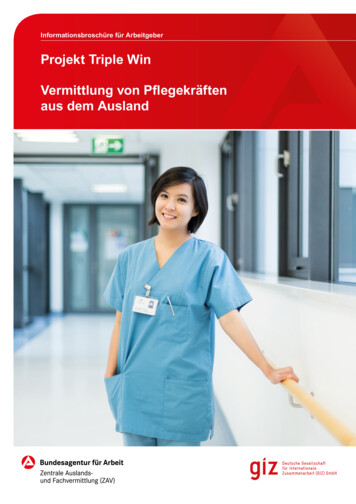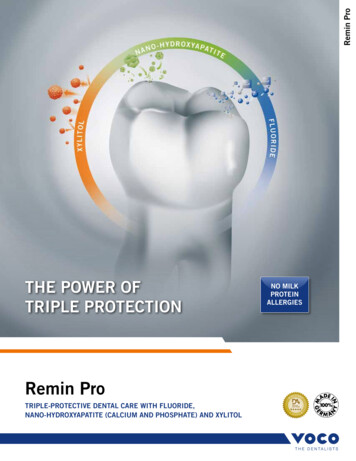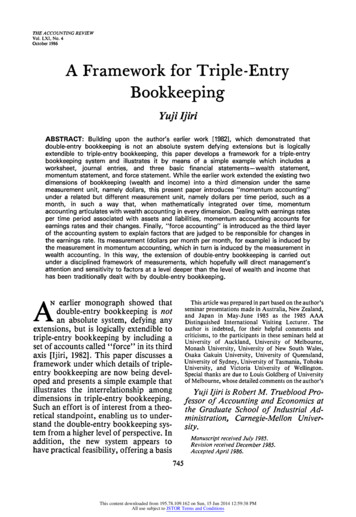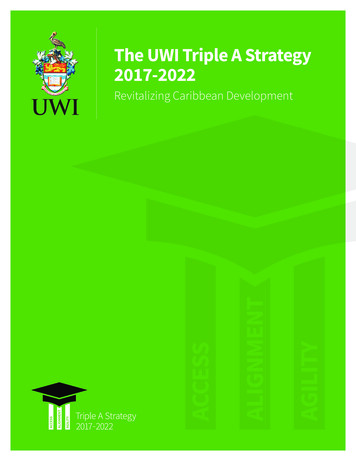
Transcription
The UWI Triple A Strategy2017-2022Revitalizing Caribbean Development
ContentsPreface . . . . . . . . . . . . . . . . . . . . . . . . . . . . . . . . . . . . . . . . . . . . . . . . . . . . . . . . . . . . . 31.0 Introduction . . . . . . . . . . . . . . . . . . . . . . . . . . . . . . . . . . . . . . . . . . . . . . . . . . 41.1The Planning Process . . . . . . . . . . . . . . . . . . . . . . . . . . . . . . . . . . . . . . . . . . . . . . . . . 51.2The Strategic Plan . . . . . . . . . . . . . . . . . . . . . . . . . . . . . . . . . . . . . . . . . . . . . . . . . . . 61.3The UWI Triple A Strategy . . . . . . . . . . . . . . . . . . . . . . . . . . . . . . . . . . . . . . . . . . . . . . 61.4Our Vision . . . . . . . . . . . . . . . . . . . . . . . . . . . . . . . . . . . . . . . . . . . . . . . . . . . . . . . . 61.5Our Mission . . . . . . . . . . . . . . . . . . . . . . . . . . . . . . . . . . . . . . . . . . . . . . . . . . . . . . . 61.6Our Core Values . . . . . . . . . . . . . . . . . . . . . . . . . . . . . . . . . . . . . . . . . . . . . . . . . . . . 61.7Strategic Objectives . . . . . . . . . . . . . . . . . . . . . . . . . . . . . . . . . . . . . . . . . . . . . . . . . . 91.8Key Performance Indicators and Expected Outcomes . . . . . . . . . . . . . . . . . . . . . . . . . . . . . 92.0 From Strategy to Action - The Implementation Framework . . . . . . . . . . . . . . . . . . . . . 112.1The Implementation Plan . . . . . . . . . . . . . . . . . . . . . . . . . . . . . . . . . . . . . . . . . . . . . . 112.2Accountability in the Implementation of the Strategic Plan . . . . . . . . . . . . . . . . . . . . . . . . . 112.3Risk Analysis of the Strategic Plan . . . . . . . . . . . . . . . . . . . . . . . . . . . . . . . . . . . . . . . . . 113.0 Summary and Concluding Thoughts . . . . . . . . . . . . . . . . . . . . . . . . . . . . . . . . . . . 13The UWI Triple A Strategy 2017-20222
PrefaceFine universities are not established and fundedto serve themselves but to commit to engage thechallenges facing their host communities. In thisregard the primary mandate of The Universityof the West Indies (The UWI) is to serve in theadvancement of the Caribbean community andsustain its development.The UWI’s strategic plan for the period 2017-2022,emerges from such an understanding of the roleof the University within its national, regional andglobal environments. But the quality of its survivalas the premiere regional academy is a prerequisiteto its effective service. Keeping its house in goodoperational order is necessary to empower thecommunity and the world beyond. The plan,therefore, captures the multilayered meaning ofthe University’s mission.Academic and entrepreneurial empowermentthrough teaching and learning, and rekindlingthe agenda of applied research and professionaltraining are critical to building the region’s resilienceand promoting the praxis of relentlessly pursuingsustainable development. The urgency of this isevident from a clear reading of the regional contextwhich shows the slow and sluggish economicrecovery from the global financial recession.depend upon the strengthening of these pillars ofservice and survival.No plan can stand without a culture of accountabilitythat holds each in an effective orbit to all. Mentoring,monitoring and measuring are the frames that holdeach pillar upright. Community engagement fordevelopment therefore results from the practiceof personal passion and performance progress.The collective outcome will rekindle the activistacademy that addresses the regional agendain the context of each national community thatconstitutes the Caribbean world.This Triple A Strategy, then, is a plan perfectly suitedto the period imagined and engaged. It is conceivedwithin the continuing context of sustained publicservice and persistent institutional excellence andendurance. To propel the people of the regionalong a progressive and prosperous path is boththe University’s intention and its salvation.Professor Sir Hilary BecklesVice-ChancellorThe University of the West IndiesDeemed the Triple A Strategy, this plan rests uponthree primary pillars: Access, Alignment, andAgility. Wealth creation and reduction of socialinequality through greater and more affordableaccess, efficient and effective alignment withsociety and economy, and enhanced agility inpursuit of opportunities are the strategic goalsresiding at the plan’s core. The greater relevanceand persistent pedagogical dignity of the UniversityThe UWI Triple A Strategy 2017-20223
1.0IntroductionThe University of the West Indies (The UWI) Triple AStrategy 2017-2022 marks the fifth iteration of theinstitution’s formal involvement in strategic planningexercises, with its first strategic plan authored in1997. Since then, the external environment withinwhich The UWI operates has changed drastically,especially with the implementation of the GeneralAgreement on Trade in Services (GATS) by theWorld Trade Organization (WTO)1. Using Porteriananalysis (Five Forces Model of Industry Competition)as the lens through which to view the operatingenvironment in which The UWI now conducts itsaffairs, the model shows that the barriers to entryinto the higher education sector have reducedsignificantly, mainly due to liberalization of thesector. Students, the main buyers of The UWI’sservices, now have more tertiary education choices.Similarly, faculty and staff, the main suppliers of TheUWI’s core business offerings—Teaching, Learningand Research—have also become more mobile.Further, the level of substitutes as proxied by themodalities students use to participate in highereducation, has grown exponentially (e.g. an increasein online versus face to face offerings). With all theseforces working together, the logical conclusionis that the environment for higher education hasbecome hyper-competitive at the national, regionaland international level.Indeed, an environmental scan of the numberof players in the tertiary education sub-sectorof the higher education industry across theCaribbean shows that there are over 50 institutionsoffering tertiary educational opportunities to thepopulation2. Coupled with this intense competitionin the market is the increasing number of nationalinstitutions that are also competing with The UWI forfunding from their national governments. All thesechanges are happening at a time when the fiscalsituation in almost all the countries of the regionmake for uncomfortable reading. The twin problemof high debt and anaemic growth in national output(Gross Domestic Product (GDP)) narrows the fiscalspace from which national governments can fundhigher educational institutions.Within the context of the above describedenvironment, The UWI has formulated its strategicplan for the period 2017-2022. Like all forwardthinking institutions, The UWI read the environmentand from its best thinking and collective thoughts,fashioned the Triple A Strategy that not only seeksto ensure its own survival but one geared towardsassisting Caribbean nations to move to higherlevels of economic growth and development. Theplan is based on the fundamental assumption thatwithout strong Caribbean economies, The UWI willnot be strong and similarly, without a strong UWI,Caribbean economies will find it more challengingto achieve significantly higher levels of economicgrowth and transformation. Put differently, thisplan recognizes the symbiotic relationship betweenThe UWI and Caribbean economies, and the needfor both to work closely together to strengthen thecompetitive position of regional economies. Thisassumption is central to the formulation of theTriple A Strategy.For a detailed account of how the GATS agreement will impact thehigher education landscape, see Beckles, H. McD (2004): UWI at Risk:GATS/ WTO and Higher Education Liberalization in the Caribbean.University Council, April 19, 2004.1While the number of players in the higher education market hasincreased, it must be noted that all the players are not of the same qualityand as such, the need for strong quality assurance systems is paramount.Already, the key players such as regional academic institutions andnational governments are paying attention to this issue and haveestablished national accreditation bodies to oversee quality issues.2The UWI Triple A Strategy 2017-20224
1.1 — The Planning ProcessIn May 2015, the newly elected Vice-Chancellor,Professor, Sir Hilary Beckles provided a broadconceptual vision of where The UWI should focus itsattention. Dubbed the “Triple A”, this vision was workshopped among the various key stakeholder groups—including governments, private sector, regional andmultilateral institutions, international academicpartners, The UWI Executive Management Team (EMT),student bodies and alumni, among others.In September 2016, the Vice-Chancellor formallylaunched the strategic planning process with a“sense-making” retreat of the EMT along with theexternal members of The UWI Strategy Committee,at the St. Augustine Campus. This retreat was aimedat providing critical analysis of the “Triple A” vision,and to draft preliminary ideas on the way forward.The retreat was facilitated by an accomplishedstrategy facilitator, with regional and internationalexperience.The University Office of Planning (UOP) in preparationfor the sense-making retreat, provided outputs froman extensive amount of preparatory work whichfocused on the critical trends in higher education, theheadwinds that The UWI has to bear in mind in theplanning process and also, SWOT and TOWS analysesof The UWI operations derived from a survey ofUniversity staff and faculty across the region.Following the September 2016 retreat, the UOPengaged in an analysis of the sense-making exerciseto pull together the output from this retreat. Thisproduced the draft one-page strategic plan.During the period October to December 2016, theUOP organized wider consultation with all campusesand the University’s Regional Headquarters (RHQ)to derive the collective thoughts from all facultyand staff, specifically on the one-page plan thatemanated from the EMT retreat. This resulted in theestablishment of campus planning teams, led bysenior academics and planning officers.The teams were asked to host campus-wideconsultations with all levels of staff and faculty tointerrogate the draft one-page plan, with the intentto deliver the following:1. agreement on The UWI: Vision Mission Core values Objectives Expected outcomes, and,2. identification of impactful initiatives that TheUWI should undertake over the next five years totransform the institution in light of the changingenvironment in which it operates.Weekly meetings were held with the teams’ leadsand the UOP to ensure that consultations as wideas possible were taking place with all staff, studentsand faculty at the campuses and the RHQ.The process of consultation between October andDecember 2016 culminated with an all-inclusiveretreat on December 8-9, 2016 at the Cave HillCampus where 115 members of staff at all levelswithin The UWI system, and students representedby their guild presidents, participated in two fulldays of discussions and deliberations based on theoutput from each campus and the RHQ. Again, thisDecember retreat was facilitated by an accomplishedstrategy facilitator.Subsequent to the December retreat, the UOPconducted a weeklong Work Activity Room (WAR)session to analyze the huge volume of informationgathered from the retreat and the varioussubmissions from the campuses/RHQ. This led to asignificant revision of the draft one-page plan andthe attendant strategy map.The output from the UOP WAR engagement waspresented to the EMT on January 15, 2017. TheCampus Principals, Pro Vice-Chancellors, Bursar,Registrar, Directors and other owners of the keyinitiatives were asked to share the draft plan with theirThe UWI Triple A Strategy 2017-20225
various stakeholders in order to receive feedback forits refinement. A formal presentation was made tothe EMT on February 3, 2017. Subsequent to thisformal presentation, the draft plan was presentedto all the Boards at the University meetings fromFebruary 6-10, 2017. The draft strategic plan wasalso sent to the external members of the StrategyCommittee for comments and feedback.Over the period March 9-29, 2017, the UOP alsoengaged in a series of meetings with all campusesand the RHQ to seek their feedback on the draft planand to provide clarification on the way forward.This wide consultation with all stakeholders, theircollective thinking and feedback are reflected inthis document, which embodies The UWI Triple AStrategy for implementation effective August, 2017.1.2 — The Strategic PlanThis strategic plan embodies the choices that TheUWI has decided on for the next five years in orderto fulfill its mission and vision as agreed on by allstakeholders. It shows how the University will utilizeits resources and capabilities in order to achievemaximum outcome in the quest to revitalizeCaribbean development and to ensure its ownlong-term survival. The tremendous opportunitiesthat lie ahead for the University and the Caribbeanregion, despite the challenges and threats in theoperating environment, have forced the institutionto use its strengths to overcome weaknessesin its operation so that it can fulfill its mission,create value for the society it serves and, not onlysurvive but prosper in an increasingly, inhospitableglobal environment. The UWI’s strategic responsetherefore, is captured in this Triple A Strategy:Revitalizing Caribbean Development. The UWITriple A Strategy Framework and the StrategyMap are presented in Figures 1 and 2.1.3 — The UWI Triple A StrategyThe plan is grounded in the vision that The UWIneeds to facilitate an access revolution in highereducation in the Caribbean region given the lowlevel of enrolment at the tertiary level, regionally andalso among members of the Caribbean diaspora.Similarly, while access is critical, The UWI alsosees the alignment with industry as an importantelement of its mandate, to help to strengthen theinnovation capacity and capabilities of regionaleconomies and lead to higher levels of growth.Further, while The UWI recognizes the anaemicgrowth of Caribbean economies, it sees potentialopportunities in the international marketplace andas such, has to become more agile in order to takeadvantage of these opportunities. It is these threeconcepts (Access, Alignment, Agility) which groundThe UWI’s strategic response to the challenges andopportunities in its operating environment.1.4 — Our VisionIn order to effectively execute its Triple A Strategy,The UWI has settled on the vision to be: An excellentglobal university rooted in the Caribbean.1.5 — Our MissionSimilarly, a strong mission is linked to The UWI’soverall vision of excellence: To advance learning,create knowledge and foster innovation for thepositive transformation of the Caribbean and thewider world.1.6 — Our Core ValuesIndeed, to make The UWI’s vision and mission areality, the University must live the core values of: Integrity Excellence Gender Justice Diversity Student CentrednessAltogether, the vision, mission and core values mustbe lived in order for the University to achieve its targetsand outcomes over the five-year planning cycle. Thevision, mission and core values provide the lensthrough which the University will make its strategicchoices as reflected in the strategic objectives.The UWI Triple A Strategy 2017-20226
The UWI Triple A Strategy 2017-20227THEMEVISIONMISSIONCORE VALUESSTRATEGIC GOALSSTRATEGIC OBJECTIVESTOP 3 PRINCIPAL OUTCOMESNumber of students enrolled in senate-approvedundergraduate and postgraduate programmesTarget: 65,000 students enrolled by 2022Number of paid-up users of University productsand servicesTarget: 50% increase in paid-up usersNumber of research publications in ranked refereedjournals per full time (FT) academic staffTarget: 2 research publications per staff per year123AC4 Improving the quality, quantity and impact ofresearch, innovation and publicationNumber of patents commercialized by industryTarget: 4 patents commercializedExternal stakeholders perception scoreTarget: 80% perception score3Number of spin-off companiesTarget: 8 spin-off companies21MarginTarget: 2%Internal and external stakeholders satisfaction scoreTarget: 80% satisfaction score3Number of physical satellite locations outside ofthe CaribbeanTarget: 5 physical satellite locations21AG5 Foster the digital transformation of The UWIAG4 Foster a creative, caring, accountable, motivated,professional (CAMP) teamAG3 Generate economies of scale and scope for The UWIAL3 Promote a cohesive single UWI brand consciousnessAC3 Improving the quality of teaching, learning andstudent developmentAG2 Restore financial health to The UWIAL2 Increase and improve academic/industry researchpartnershipsAC2 To be the university of first choice for alumni andnon-student customers seeking products andservices for all things CaribbeanAG1 Establish a physical presence of The UWI on allcontinentsAgilityAL1 Promote greater activism and public advocacyAlignmentAC1 To be a university for allAccessIntegrity Excellence Gender Justice Diversity Student CentrednessTo advance learning, create knowledge and foster innovation for the positive transformation of the Caribbean and the wider worldAn excellent global university rooted in the CaribbeanThe UWI Triple A Strategy 2017-2022: Revitalizing Caribbean DevelopmentFigure 1: The UWI Triple A Strategy Framework
The UWI Triple A Strategy 2017-20228LEARNING LER/OUTCOMESTUDENTS rning& StudentDevelopmentAC1Universityfor AllAG5DigitalTransformationof The UWIAC2First choicefor customersseekingproducts &servicesAG4A Creative,Caring, Accountable,Motivated &Professional(CAMP) TeamAG3Economies ofScale & ScopeAG2FinancialHealthAL1Activism & PublicAdvocacyAG AgilityAL3SingleUWI BrandConsciousnessAG1The UWIpresence on allcontinentsAC Access AL AlignmentAC4Research,Innovation psTHE UWI — Accessible Aligned AgileFigure 2: The UWI Strategy Map
1.7 — Strategic ObjectivesStrategic goals serve as the guiding framework fororganizing The UWI’s priorities over the next fiveyears. While each strategic goal includes a myriadof possibilities that the institution can pursue overthe planning period, given its limited resources andcapabilities, it has to make choices about which willbe pursued over the 2017-2022 planning period.As such, 12 broad objectives are identified over theperiod 2017-2022. These are captured in Tables 1a-c.1.8 — Key Performance Indicators andExpected OutcomesAn important part of strategic planning is the needto have measurable outcomes at the end of theplanning cycle. As such, attached to each strategicobjective at the University level, are Key PerformanceIndicators (KPIs) that will be used to measure theprogress that the University is making towards theachievement of its mission and vision. The plan hasidentified nine principal outcomes which it seeks tohighlight as the University moves towards achievingits vision and mission for the planning period. Theseprincipal outcomes are presented in Table 2.In summary, the broad
Agility Wealth creation and reduction of social inequality through greater and more affordable access, efficient and effective alignment with . The UWI Executive Management Team (EMT), student bodies and alumni, amo
